-
Categories
-
Pharmaceutical Intermediates
-
Active Pharmaceutical Ingredients
-
Food Additives
- Industrial Coatings
- Agrochemicals
- Dyes and Pigments
- Surfactant
- Flavors and Fragrances
- Chemical Reagents
- Catalyst and Auxiliary
- Natural Products
- Inorganic Chemistry
-
Organic Chemistry
-
Biochemical Engineering
- Analytical Chemistry
-
Cosmetic Ingredient
- Water Treatment Chemical
-
Pharmaceutical Intermediates
Promotion
ECHEMI Mall
Wholesale
Weekly Price
Exhibition
News
-
Trade Service
Switzerland-based Sukano, a global company specializing in the development and production of additives, masterbatches and compounds for polyester and specialty resins, recently partnered with Sidel to technically demonstrate manufacturing from recycled materials Feasibility of blackout white opaque PET bottles, but also production at the same outp.
Sukano's recycling cycle diagram
Sukano's recycling cycle diagramWhile there has been overall progress in recycling PET, challenges remain in recycling white PET bottl.
Can white opaque masterbatches be used in PET monolayer bottles? Will up to 100% recycled material affect production and/or final product properties such as light-shielding?
In response to these challenges, Sukano and Sidel decided to technically prove that all white opaque masterbatch formulations designed by Sukano can indeed be used in PET monolayer bottles, using Sidel's latest generation EvoBLOW™ blow molding machine, Still process at the same output speed without compromising color, performance, function and yie.
Sukano's team of technical experts started by formulating masterbatches for single-layer PET white bottles and submitting them for use in materials recycled using the European PET Bottle Platform ("EPBP") protoc.
As a result, the viscosity, pressure, and stability of the melt were considered to have good processability, and in addition, high-quality melt filterability demonstrated its purity and consisten.
The melt also exhibits a very stable color, with the final material remaining white in all grades, which is highly similar to the original virgin PET white bottle, but using 100% recycled P.
Finally, the IV is also stable, maintaining an IV level of 65 at all stages of recycling PET, and the solid phase polymerization process ("SSP" for short) has demonstrated an IV value similar to that of virgin PET (7/
One of the key factors is that no aggregation has been found, thanks to the formulations and ingredients used by Sukano's technical experts, including the selection of compatible and stable surface treatment techniques for raw materials during the recycling proce.
“The results were not surprising, and we are satisfied that we have scientifically proven and confirmed them,” said Michael Kirch, Sukano’s Global Head of R&.
Sidel uses 25%, 50% and 100% recycled material to produce blackout white opaque R-PET bottles on its high-speed PET blow moulding machines when expertly designed formulations successfully meet the highest blow moulding requiremen.
In addition to bottles containing 100% recycled PET, the shading properties can be adjusted by adding a white PET masterbatch formulation designed by Suka.
In this case, there is little discernible difference in color from the bottle made from the virgin material, and the integrity of this light barrier is demonstrated under extreme conditions, such as at 550nm, where the light transmittance is less than
“We found no significant difference in processing conditions or blow molding output when processing 100% recycled white PET made from Sukano designed white masterbatches, even under the most challenging conditio.
In conclusion, one of the greatest achievements of the collaboration was the demonstration that blackout white opaque PET bottles can indeed be recycled up to 100% bottle-to-bottle, either in the same product or upgraded for use in new value-added are.







